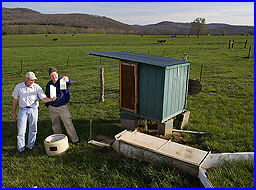



A Breath of Fresh Air for Livestock Farms
US - Animal-rearing facilities may soon be taking a cue from human hygiene. An Agricultural Research Service (ARS) scientist in Fayetteville, Ark., has found that aluminum chloride—a common ingredient in deodorant sticks—helps minimize the nose-prickling vapors that tend to concentrate in and around swine and dairy facilities. |
| Soil scientist Philip Moore (right) has spent the last 14 years trying to reduce environmental burdens associated with animal waste. Here, Moore and technician Scott Becton collect runoff water samples from a long-term study to measure phosphorus runoff from alum-treated poultry litter. |
The compound, as soil scientist Philip A. Moore, Jr., discovered, can also significantly slash troubling ammonia emissions that are typically generated when hundreds of farm animals are raised under one roof.
Moore, who works in the ARS Poultry Production and Product Safety Research Unit in Fayetteville, has spent the last 14 years trying to reduce the environmental burdens associated with animal waste, including poultry litter.
Manure from poultry, dairy and swine facilities serves as valuable fertilizer for farmers' fields. But only if it's applied in the right dosage. Too much phosphorus-rich waste can foul water supplies and wreck fragile marine ecosystems.
In response to concerns about phosphorus pollution and chicken houses, Moore first discovered the power of aluminum, in the form of aluminum sulfate (or alum), in 1992. Alum grabs onto the phosphate in poultry waste, keeping it from escaping into waterways. It also reduces the buildup of ammonia gas in chicken houses.
Because of Moore's research, almost 700 million chickens are raised each year in the United States using alum.
More recently, the researcher found an even better aluminum performer for treating the liquid manure associated with pigs and dairy cows: aluminum chloride.
Unlike alum, this compound doesn't generate smelly, sulfuric gasses when applied to liquid waste. And aluminum chloride can impressively—and cost-effectively—reduce phosphorus runoff and atmospheric ammonia levels in animal facilities.
That's significant, since high atmospheric ammonia levels threaten the respiratory health of both animals and farm workers. They also negatively affect water quality by increasing atmospheric nitrogen deposition.
ThePoultrySite News Desk








